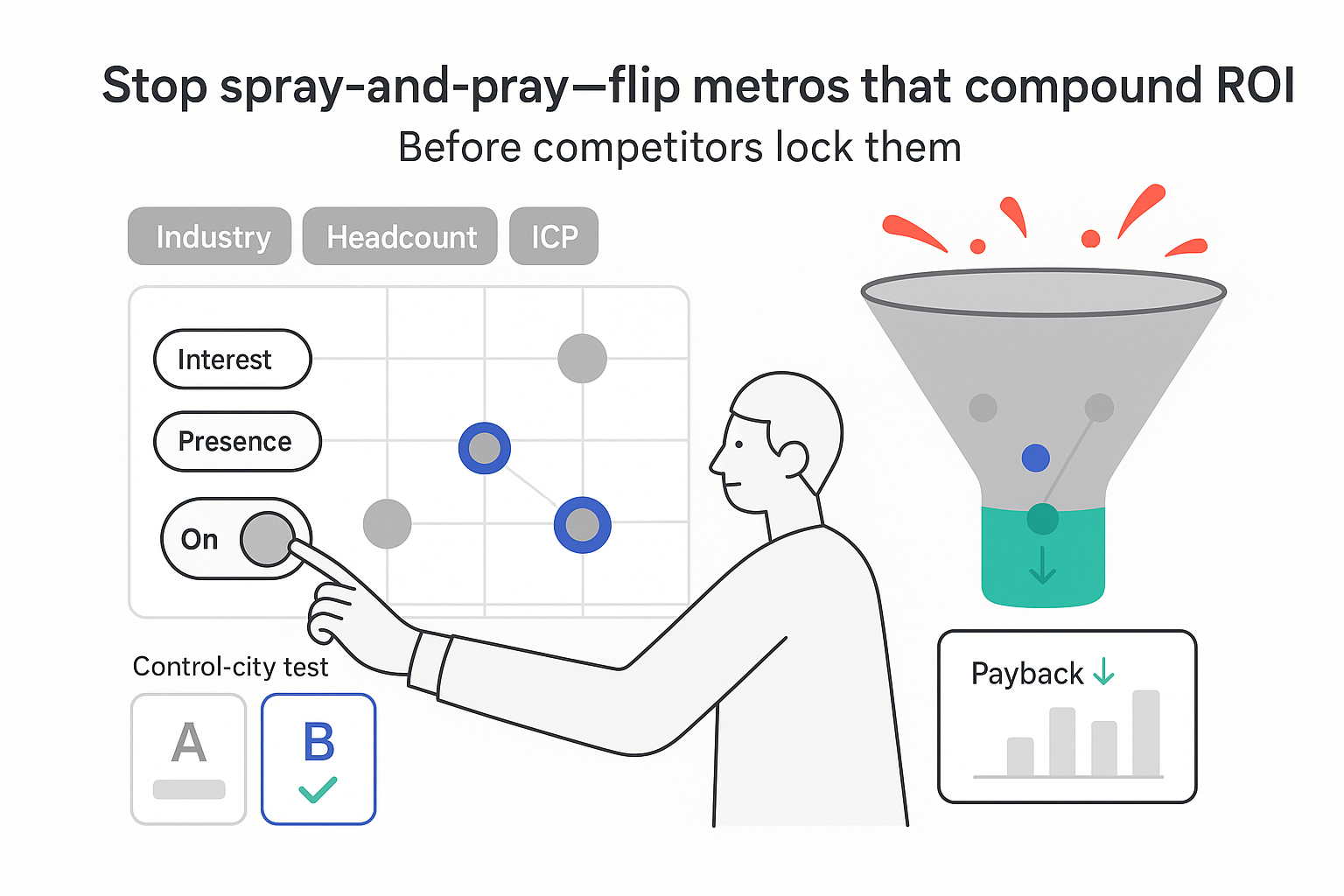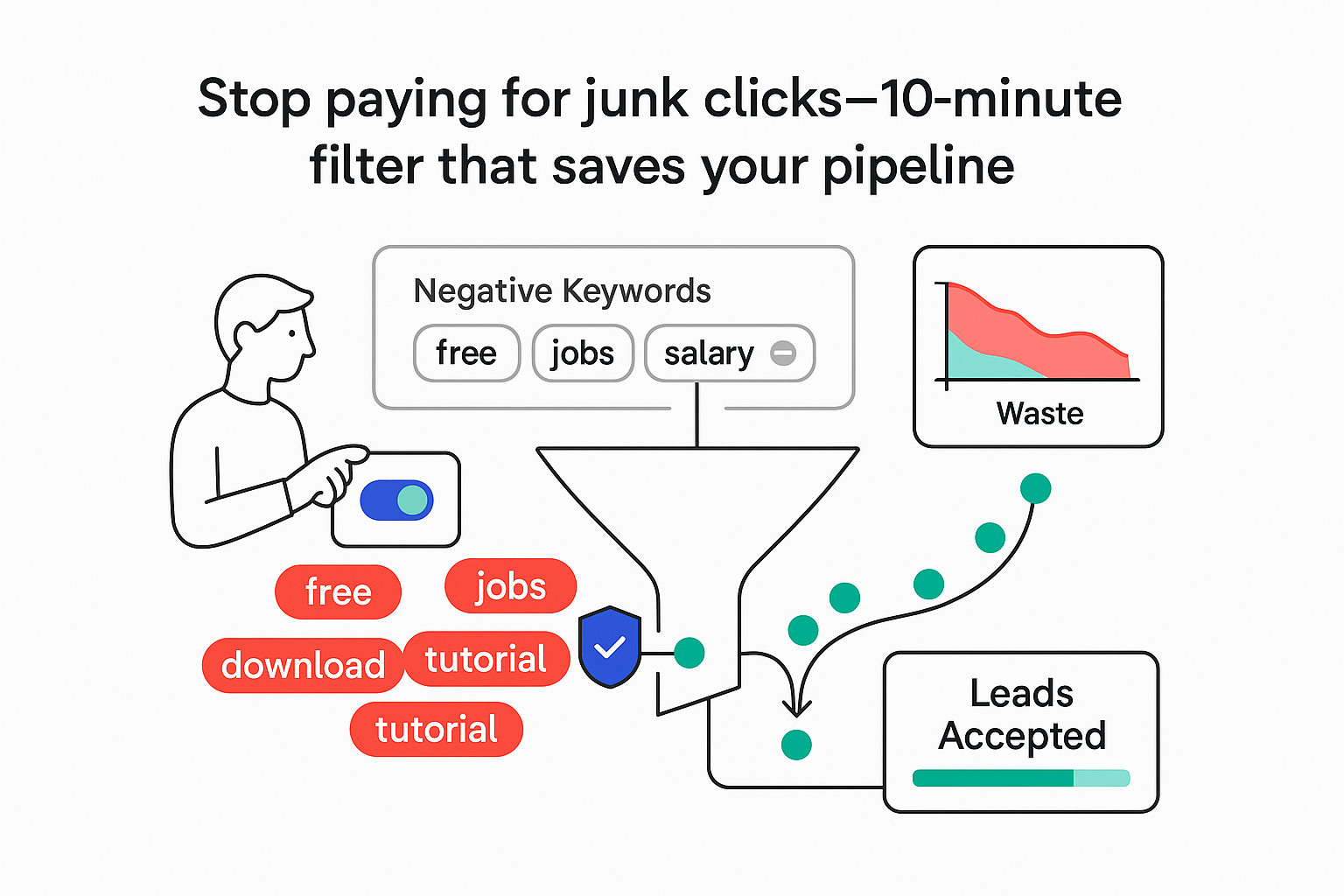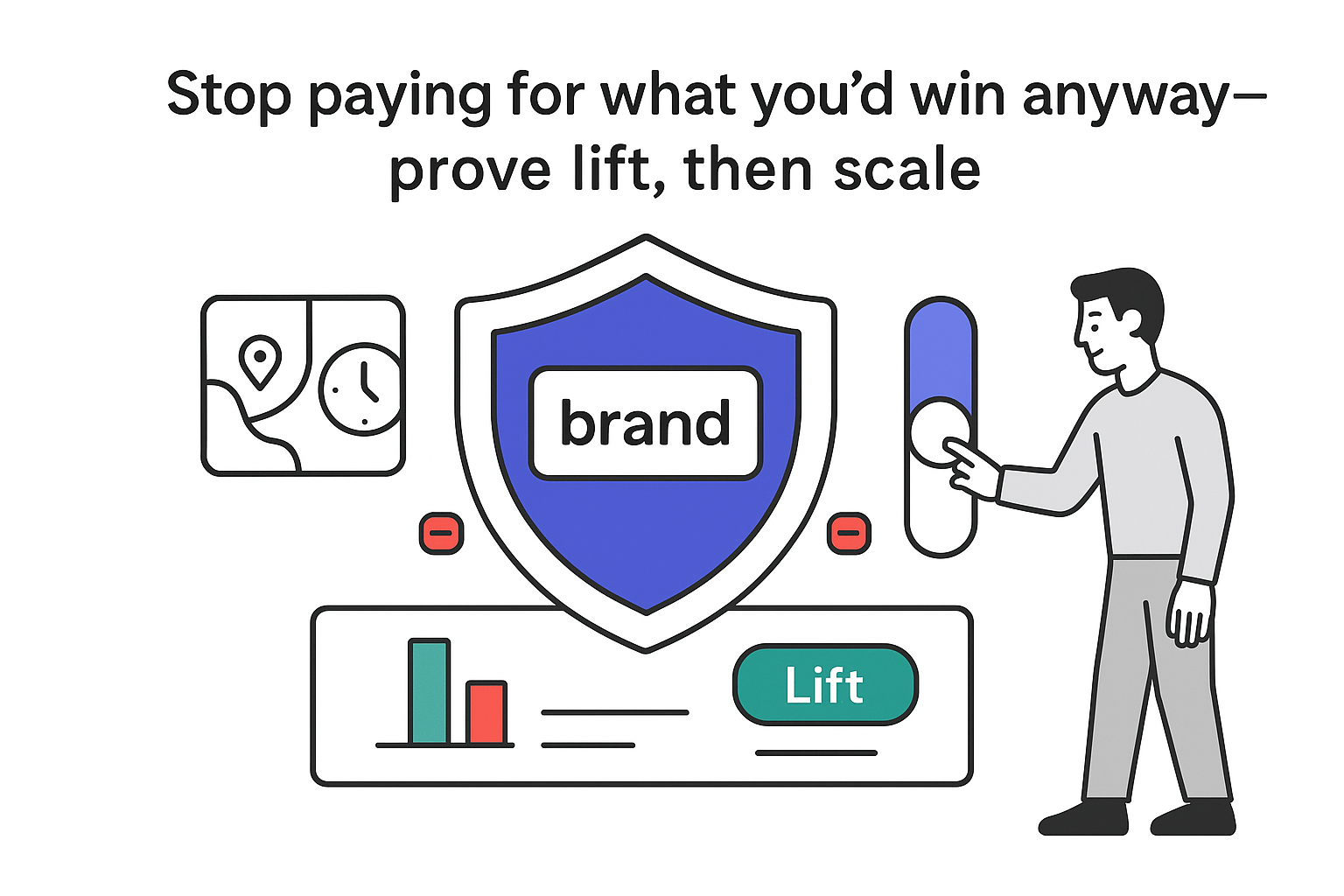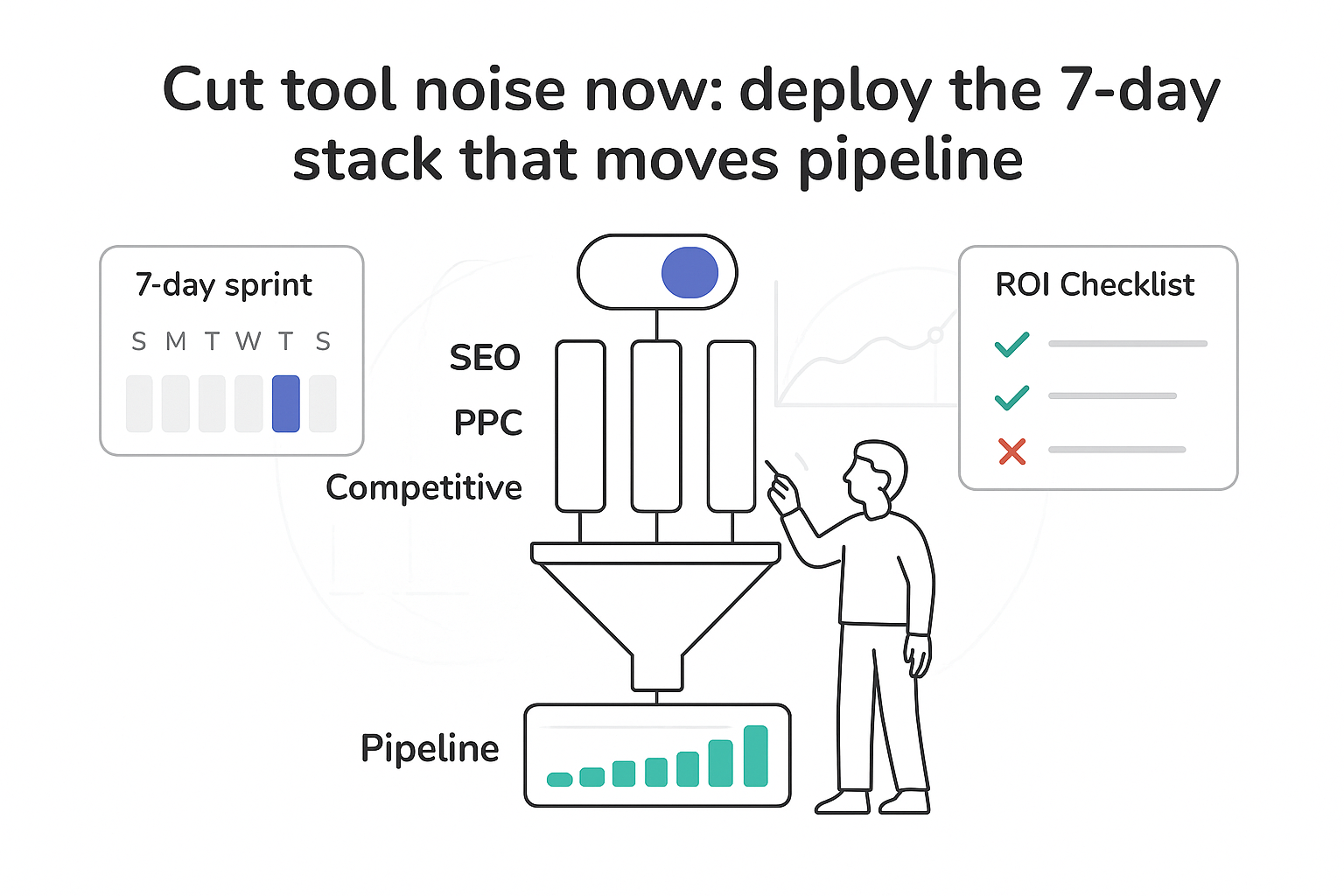I am busy. I want organic growth that shows up on a dashboard, not in vague promises. The good news: I do not need a long rebuild to get moving. These quick moves take about an hour and push on the signals search engines weigh now - clarity, entity trust, click appeal, and paths that lead buyers from intent to contact. None of this is fancy. It is focused. And it compounds. Think stopwatch, not six-month plan. One page. One keyword. One next step.
For a quick real-world example of fast wins, see How a Local Plumber Unclogged His Lead Flow: A 30-Day Local SEO Case Study.
7 B2B SEO quick wins in under 60 minutes
Calibrate one high-intent service page
Time: 10-15 min
If one page earns quick attention, it is my top-revenue service. I map that page to a single buyer-intent keyword. I pull candidates from Google Search Console (Performance > filter for queries that already bring impressions to that URL). If volume or intent is unclear, I sanity-check in a trusted keyword tool. If two or three phrases are close, I choose the one with the clearest decision intent. That focus wins clicks and reduces cannibalization.
I rewrite the title tag so it says what I do, for whom, and why it helps. Useful B2B formats:
- [Service] for [ICP] | [Outcome or Pain Solved] | [Brand]
- [Service] for [Industry] | [Proof point] | [Brand]
I match the H1 to this language so the page handshake is tight. I trim the meta description to ~150-160 characters and end with a simple, outcome-oriented nudge. No hype.
I add proof near the top - two or three client logos and one line like "Cut onboarding time by 38% for a mid-market IT firm." If I cannot name clients, I anonymize outcomes.
Quick checks:
- The primary keyword appears naturally in the title tag, H1, and first paragraph.
- The URL slug is short and descriptive. If I cannot change it now, I leave it and move on.
- The first screen shows proof before fluff.
KPI: I watch click-through rate in Search Console for that page. In my experience, CTR lifts often appear within 7-14 days as the new title and description get crawled (timing varies by crawl frequency and query demand).
Build internal paths that concentrate relevance
Time: 10-12 min
My site already contains authority. I put it to work. I identify five to ten pages that search engines trust on my domain - usually the homepage, top blogs, case studies, and an About page with press mentions. From each, I add one contextual link to my target service page using descriptive, natural anchor text such as:
- "B2B accounting automation services"
- "Managed security for SaaS companies"
- "Cloud migration for healthcare teams"
If it reads odd, I rewrite it. I also use a quick helper: site:mydomain.com "service phrase" to find mentions worth linking from. If it helps users, I surface the service page in navigation or footer without crowding.
If a high-performing blog post already points to a newsletter or gated asset, I still add one early link (in the first third of the article) to the service page. Both can coexist.
KPI: I track clicks to the target page in Search Console from linked pages. Rankings for the target term often improve within two to four weeks, depending on crawl pace and competition.
Strengthen entity signals on and off my site
Time: 16-22 min
Google Business Profile
- I confirm the primary category fits buyer intent and add secondary categories only if they reflect real services.
- I add Services with short descriptions, and use Products to feature key service packages linked to their URLs.
- I tag the main website link with UTM (utm_source=google&utm_medium=organic&utm_campaign=gbp) so I can see clicks in analytics.
- I publish one short Post (one outcome + a data point). I seed Q&A with common buyer questions and clear answers.
- I queue two or three review requests to recent clients and ask them to mention the service by name if they are comfortable doing so.
Schema markup
- Sitewide, I add Organization schema (legal name, logo URL, sameAs links to properties I control such as LinkedIn or verified review profiles). If I maintain an office or serve a local area, I add LocalBusiness with address and phone that match my profile and footer. NAP consistency matters.
- On the target service page, I add Service schema with name, description, areaServed (if relevant), offers (price or "Contact for pricing"), and serviceType (if useful).
- I use JSON-LD and validate with Google's Rich Results Test. Google's documentation clarifies that markup helps search engines understand content; it does not guarantee a specific rich result.
Why this matters: search engines resolve entities, not just pages. Clear, consistent entity signals raise confidence for branded and service queries.
KPI: I watch impressions for branded and service phrases in Search Console over the next weeks and monitor GBP views and UTM-tagged clicks. Movement typically starts within days to a few weeks.
Earn a few credible links fast
Time: 10-12 min
I do not need dozens today - just two or three new referring domains that make sense to a buyer. Fast, credible ideas:
- Ask a technology partner to list my firm on their partner page and link to my service page with a short, accurate blurb.
- Offer a testimonial to a vendor I actually use. Vendors often link my logo and site.
- Submit to a relevant business association or niche industry directory. Quality over quantity.
Short outreach message I use:
Subject: Short blurb and link for your partner page
Hi [Name],
I have worked with [Vendor/Partner] on [project or category] for [time frame]. Happy to share a short blurb and my logo for your partner page. Would you link my name to [service page URL] so prospects can see what I do best?Draft blurb:
[One sentence problem solved] for [ICP] with [tool or approach]. Recent result: [micro case stat].Thanks for considering this.
[Signature]
Anchor suggestions to propose: my brand name for the homepage, and a descriptive service phrase for the service page. I avoid aggressive anchors.
KPI: I track new referring domains and any referral visits. Crawlers may pick up links within a few days to a few weeks.
Turn interest into pipeline
Time: 5-8 min
Traffic without action is busy work. I pick one primary action on the service page and commit to it. Examples:
- Book a strategy call
- Schedule a demo
- Request a pricing review
I keep the button text specific. I add a short form - four fields is plenty: name, work email, company, and a dropdown to qualify intent. I place a proof block above the fold with client logos and one or two micro case stats (e.g., "Reduced onboarding time by 38%" or "Cut cost per qualified lead by 27%"). For layout inspiration, see Myrtle Beach Landscaping Company - Landscape Design & More for clear above-the-fold CTAs and trust elements. I link one relevant case study as a secondary action for people who are not ready yet. If my audience is heavy on mobile, I test a sticky bar for the primary action (limited to service pages and positioned at the bottom).
I track all of this as events in analytics. I name the primary action clearly (e.g., generate_lead) and set up a simple funnel view to see where drop-off happens.
KPI: I watch for a conversion rate lift on the service page and a visible bump in qualified calls or demos. I usually see signal inside two weeks.
Verify and monitor in Search Console
Time: 8-10 min
I inspect my target service URL. If it is not indexed, I request indexing. If coverage shows simple issues (soft 404, stray noindex, conflicting canonical), I fix those first - these block progress.
In Performance, I filter by the target query. If multiple pages rank for the same phrase with low positions, that is cannibalization. I pick the owner page, then:
- Add internal links from competing pages to the owner page
- Adjust the competing pages to distinct angles or consolidate them
- Use a canonical to the owner if content is duplicative
If I changed multiple URLs, I refresh my XML sitemap and resubmit it. A quick trend note: AI overviews have added noise to some results. That makes strong titles and entity clarity even more valuable. I cannot control the whole result page. I can control how my result looks and how my site signals expertise.
KPI: impressions, CTR, and average position for the target query over 14-28 days. Early signs often show in the first week.
This looks like a lot. It is not. I just shipped seven small, pointed moves that teach search engines what I do, send visitors to the right place, and help real buyers take the next step. If I feel tempted to keep tweaking, I set a reminder instead. I give changes time to settle, watch Search Console and analytics, note what moved, and then repeat the same rhythm on the next service page. One page. One keyword. One next step. That is how quick wins turn into steady growth.
Want more step-by-step tasks you can run next? Grab my Giant Local SEO Checklist 2025.







.svg)